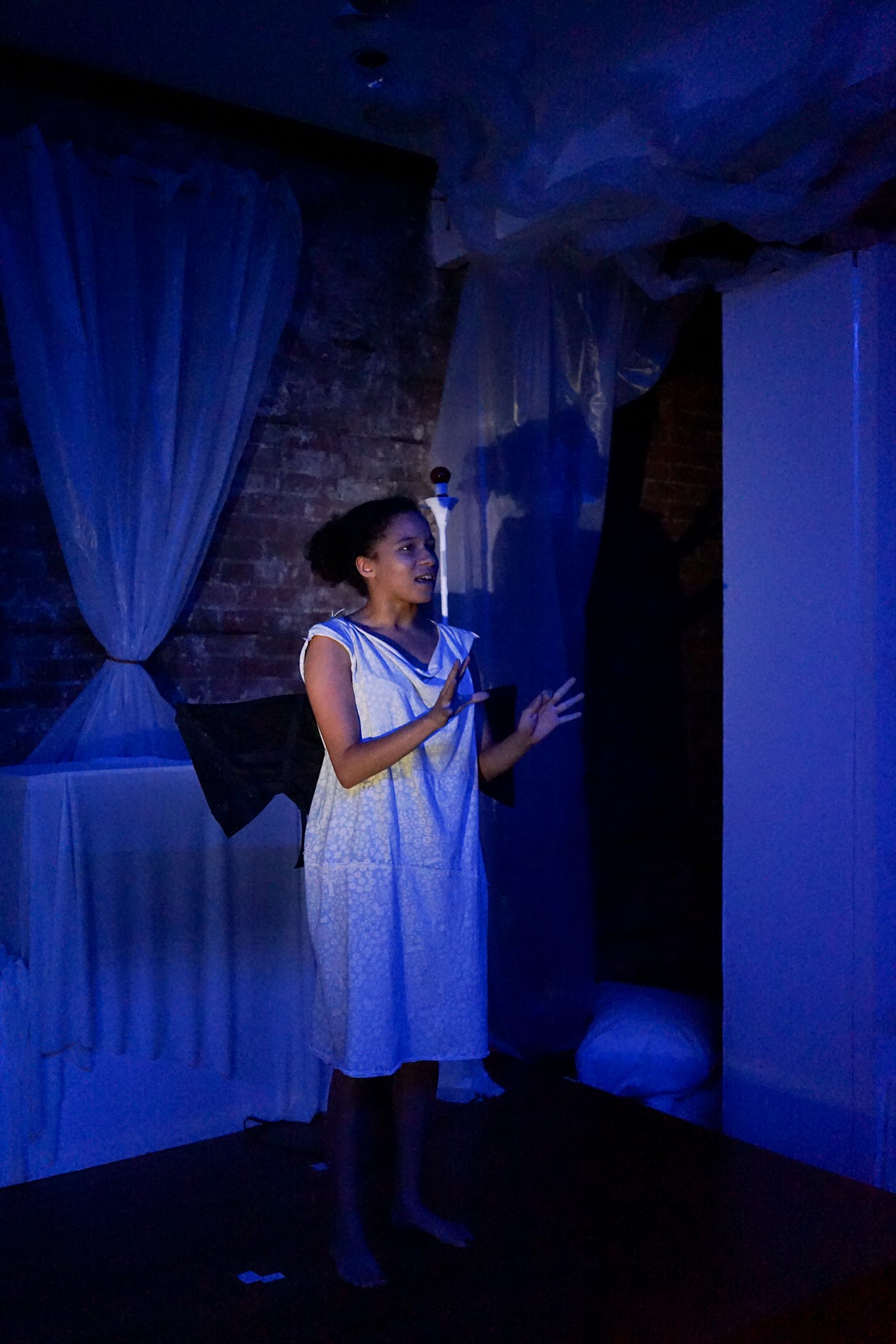
Two new experimental new works from Exquisite Corpse Company flirt with immersive
The Parlour’s art gallery is a wide open-floor environment, but there is a wonderful door in the far corner of the space. When this threshold opens, it’s as if a deep yawn reveals two steep steps that bring you fully into an intimate playspace. To the left of the entrance door, long strips of plastic that range from clear to hauntingly opaque dangle from the walls behind the small platform and drape from the balcony and staircase on the opposite side of the room. They rustle and wave slightly as the audience situates themselves into rows of chairs facing the platform, evoking a clinical and dystopian aura.
This setting was the non-traditional venue chosen by Exquisite Corpse Company to showcase their 2018 summer festival, This is A Distraction, which challenged and analyzed the placement of personal identity in the fast-paced world of today.
The following comments upon two of the four plays in the festival.
‘LILIYA’
A short, sharp click illuminates a slide that reads Moscow, 2005. It hovers at the front of the dark room for a long pause, thus transporting the audience into the world of Liliya.
Loosely speaking, the work is based on the real-life experience of Liliya’s playwright, Alexis Roban, who contracted a case of mono that resulted in an erroneous diagnosis of diphtheria and a hospital quarantine in Russia.
But through the stream of consciousness style of Roban’s writing, the hour-long work pulls at existential threads that surround a young sick American woman, her Spanish doctor, her Russian nurse, and her fantasies around her British boyfriend. In one moment there is a doughnut and vodka on stage and in the next, a ouija board and a self-proclaimed “Bat-Man.”

In parallel with the slightly absurd action, the stage transforms from a sharp clinical white to new textures of colors as layers of the set are stripped away. Two light bulbs sit on stands on stage-left. While the structure is usually referred to as a window, the two erect pillars create a portal for fantasies to breeze in and out of the ever-changing interior locations — from the hospital ward, a Russian apartment, or a dimension in between the two.
Amidst the chaos, there is a calculated structure. Moments and lines within the scenes that are rich and fulfilling to an audience member following the minutes of either ranting or desperate monologue. Even when characters are speaking to one another in Liliya, they never seem to fully address the actual question posed to them by their counterparts, rather they float in large lofty observations or duck and weave in tight angry inspections. Yes, there is only one explicit patient in the plot, but it is clear that all of the characters have caught the same virus and suffer from both shared and individual mental, emotional, and physical ailments. Use of the balcony and staircase is minimal, as the cast is staged to infect and inflict on one another using the floor and platform stage directly in front of the seated audience.
Get Michaela Ternasky-Holland’s stories in your inbox
Join Medium for free to get updates from this writer.
SubscribeSubscribe
Ana Mirabel’s constant bewilderment and interrogation as the quarantined twenty-something-year-old American paired with the brooding of John-Paul Stewart’s Spanish doctor yearning for Barcelona from Moscow create moments of reality that naturally fell head first into the torrid experimental scenes within the play. At the end of the work, it is obvious that the four distinct actors unabashedly delivered a heady script that explores relationships between personal identity and historical heritage, sexual drive and emotional feelings, authenticity, and appearances through the use of white sheets, a starry night-light, and a hundred-year-old baby.

‘KILLJOY’
If Lord of the Flies replaced adorable British schoolboys with cunning federal agents and submissive, but deadly soldiers, then it would almost be the world of Alisa Zhulina’s Killjoy. The final detail would be to turn the lush tropical island into a top-secret training camp caught in a mysterious dust bowl — that may or may not be the consequences of dimensions of reality colliding, a nuclear explosion or The Rapture. Who really knows?
Killjoy takes place in the world where alternate facts, half-truths, and mental manipulation warp and control perceptions of power hierarchy, gender, and what the hell is actually going on. Agents may or may not have orders to kill, poison, or shoot one another, while simultaneously trying to get into each other’s pants or the pants of their military trainees.
Thus as the storm rages outside the isolated base, the inside begins to meltdown. A hardcore psychologist, played by Isuri Wijesundara, struggles to keep her program alive and its structure in place as her female identity, race identity, and place of power. These personal foundations are constantly challenged, undermined, and jolted by her unraveling scientist colleague named Alex, portrayed tenderly and frightfully humanely by Lee Collins. Don’t be fooled, as Wijesundara’s character, Nadia, is causing her own share of chaos. Wielding sexuality, mental prowess, and firearms against Alex and her trainees to her own ends in the physical and mental Hunger Games-like environment that Nadia has helped to create.
The set is simple and clean. A desk and chair on the platform portray Nadia’s office, while cots slide in and off the stage to represent the service men and women’s berths. The balcony is employed for a short scene, and the staircase is implemented for dramatic, combat-boot stomping entrances, as well as for a few drunk stumbles, Of course, there is a large bottle of wine, because who doesn’t want to toast the end of the world with a fellow murderer and countryman?
Though the directors of Killjoy and Liliya designated unique staging choices per the venue, it did not necessarily qualify the pieces as “immersive” or “site-specific.” Explicitly marketed as performance art and new plays on the Exquisite Corpse Company website, the bulk of both plots unfolded in a traditional means — directly in front of a seated audience.
But Killjoy and Liliya are new works and have the potential to still be tightened and/or expanded upon.
Liliya feeds itself on a constant loop — stuck in an infinity of looking into the past to understand the future and somehow surviving the present. Roblan’s writing successfully creates the play form of the current illogical state of the world. Paired with the undeniably individual cast, the play could experiment with its nonsensical traits through its staging, transitions, and engagement and positioning of its audience.
And according to Killjoy’s director Julian Carucci, there are many different endings and scenes still in play for Killjoy. The version shown for This is A Distraction is just as safe and truthfully permanent as the characters words and desires within the work. The suspense of what the next iteration of Killjoy could be is exciting. If a longer, more continuous run is on the horizon for Killjoy, its playwright and director could explore the maze-like twists and turns, which have the potential to evolve and rotate through various versions of the story that could unlock per the smallest directorial, actorial, or audience-centered factor.
This is a Distraction has concluded. Exquisite Corpse Company currently has an installation on Governor’s Island titled Memory House.
NoPro is a labor of love made possible by:

…and our generous Patreon backers: join them today!
In addition to the No Proscenium web site, our podcast, and our newsletters, you can find NoPro on Twitter, Facebook, YouTube, Instagram, and in our online community Everything Immersive, and in our Slack forum.




















Discussion